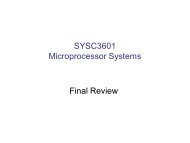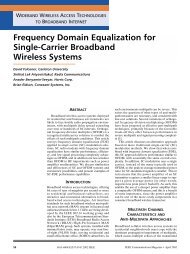Image Reconstruction for 3D Lung Imaging - Department of Systems ...
Image Reconstruction for 3D Lung Imaging - Department of Systems ...
Image Reconstruction for 3D Lung Imaging - Department of Systems ...
Create successful ePaper yourself
Turn your PDF publications into a flip-book with our unique Google optimized e-Paper software.
is selected, measurements are taken using only the remaining N − 2 electrodes. This allows<br />
N −3 possible voltage measurements to be made using a single reference. The total number<br />
<strong>of</strong> measurements possible is there<strong>for</strong>e N(N −1)(N −3)/2. For n = 16 this is 1560 individual<br />
measurements. Any combination <strong>of</strong> electrode pair voltages can be reconstructed from this<br />
basic set. This number <strong>of</strong> measurements is valid <strong>for</strong> any electrode spatial arrangement such<br />
as 2D tomographic, <strong>3D</strong>, and planar. Of these possible pairs only a subset are typically used.<br />
The typical subsets used have been dictated in the past more by timing and system design<br />
configurations more than anything else.<br />
The next sections discuss the most well known current injection patterns <strong>for</strong> 2D configurations.<br />
In 2D configurations the electrodes define a boundary encompassing the domain <strong>of</strong><br />
interest. Here there are as many electrodes as there are electrode pairs, with each pair defined<br />
as being the neighbours along the boundary path. The electrodes in this configuration<br />
also define a plane <strong>of</strong> intersection with the object being imaged.<br />
2.5.1.1 Adjacent Pattern<br />
The adjacent drive method [16], also known as the neighbouring method, is the most common<br />
pair drive protocol. As can be seen in figure 2.2, current is applied through two<br />
adjacent electrodes and the voltages measured from successive pairs <strong>of</strong> adjacent electrodes.<br />
Current is then applied through the next pair <strong>of</strong> electrodes and the voltage measurements<br />
repeated. The procedure is repeated until each possible pair <strong>of</strong> adjacent electrodes has been<br />
used to inject current.<br />
The adjacent measurement strategy provides N 2 measurements, where N is the number<br />
<strong>of</strong> electrodes. However to avoid the problem <strong>of</strong> unknown contact impedance, the voltage is<br />
not measured at a current injecting electrode thus the number <strong>of</strong> measurements is reduced to<br />
N(N − 3). The four-electrode reciprocity theorem [38][55] states that <strong>for</strong> any measurement<br />
set the mutual impedance is preserved under an interchange <strong>of</strong> injection and measurement<br />
pairs. There<strong>for</strong>e only N(N − 1)/2 <strong>of</strong> the measurements are independent. However, it is<br />
common to use all N(N − 3) measurements in most reconstruction algorithms. Thus a 16<br />
electrode system will produce 208 measurements <strong>of</strong> which 104 are independent but all 208<br />
are used in the reconstruction algorithm.<br />
The adjacent strategy requires minimal hardware to implement. With the adjacent<br />
strategy current is driven mainly in the outer region <strong>of</strong> the imaged object. The current<br />
density is highest between the injecting electrodes, and decreases rapidly as a function <strong>of</strong><br />
distance. The method is there<strong>for</strong>e very sensitive to conductivity contrasts near the boundary<br />
and insensitive to central contrasts. It is also sensitive to perturbations in the boundary<br />
shape <strong>of</strong> the object, in the positioning <strong>of</strong> the electrodes and is quite sensitive to measurement<br />
error and noise [43].<br />
A feature <strong>of</strong> adjacent drive protocol is that on a two dimensional domain the adjacent<br />
voltage measurements are all positive. This can be seen in figure 2.8(a) which shows that<br />
the potential is monotonically decreasing from source to sink. The resulting measurements<br />
will have a ‘U’ shaped graph <strong>for</strong> each drive as shown in figure 2.8(b).<br />
2.5.1.2 Opposite Pattern<br />
The opposite or polar drive pattern [14], which is commonly used in brain EIT [20], applies<br />
current through electrodes that are 180 ◦ apart while voltage differences are measured on<br />
the remaining electrodes. There are various ways to collect the voltage measurements. The<br />
most common appears to be to use the electrode adjacent to the current-injecting electrode<br />
28





